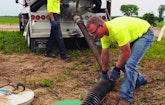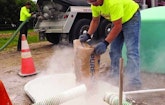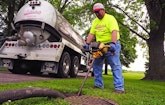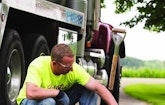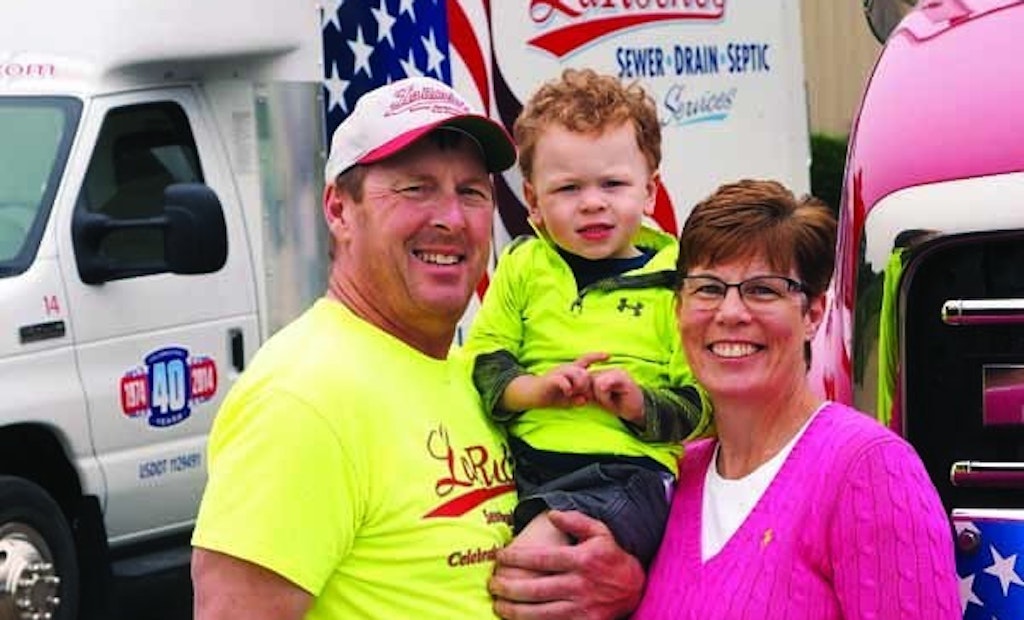
Interested in Trucks?
Get Trucks articles, news and videos right in your inbox! Sign up now.
Trucks + Get AlertsMinnesota septic operators have had some struggles over the years disposing of waste. One problem was some treatment plants refused to accept it. Although that’s changing, days and hours of operation still make it difficult for operators. Another problem was weather for those pumpers who were land-applying. In the winter and rainy seasons that became challenging, if not impossible. The obvious solution was to store septage until conditions were suitable for land application. But under Minnesota rules and regulations, companies were not allowed to do that.
In 2012, pumpers Phil and Kathy LaRoche set out to see if they could get those rules changed. They initiated a collaborative effort with other pumpers and the Minnesota Onsite Wastewater Association to open discussions with the Minnesota Pollution Control Agency (MPCA). Following a lengthy process, they were eventually successful and pumping companies can now store septage on their property.
The LaRoches operate LaRoche’s Sewer, Drain & Septic Services, in Faribault, Minnesota, a rural area about 55 miles south of Minneapolis. They live and work on a 30-acre parcel of land and also own six registered land-applying fields.
The company has been around since 1974 when Phil’s father, George, started doing septic pumping and drain cleaning. The next year they branched out into the portable restroom business and then added tent rentals. However, in the late 1990s they sold the restroom and tent division and returned to their roots focusing strictly on septic work. That had the added benefit of reducing their labor force, “which keeps the stress levels a little bit lower,” Phil notes.
Today they mostly work within about a 30-mile radius providing a complete range of septic services. “We do pumping, drain cleaning, jetting, repairs, design work, installations and inspections,” Phil says. They also clean grease traps. “We do a ton of them, but a lot of ours are 25- to 50-gallon traps underneath the sinks in the restaurants.”
PROACTIVE AND REACTIVE
The company’s staff includes part-timers daughter Amy LaRoche and Dan Ford working with Kathy, who handles the office, payroll and bookkeeping; 18-year veteran Dave Bryer, the main septic driver; and Phil’s brother, George LaRoche, who primarily handles septic compliance and designs as well as drain cleaning, working with a recent hire, Josh Tarka.
“I have always felt it’s nice to perform the drain work in tandem as far as efficiency and carrying in equipment,” Phil says. “And for mainline cleaning we use a Spartan 1065, which it’s almost a must to have two guys.” Phil says everyone multitasks and he picks up all the overflow work, whether it’s office or field related.
The team stays busy year-round not only because of the company’s broad service offerings, but because the LaRoches work hard to get everyone on maintenance contracts, which helps prevent emergency calls and balances out the workflow.
“Every month we just have a long list of where we’re going, what we’re doing,” Phil says. “We’ve got a lot of people on quarterly, semiannually, annually, whether it’s jetting or pumping or what-have-you.” Kathy adds they’re always working on customer education, both in person and through their website, emphasizing regular maintenance for the health of the system and to avoid costly repairs.
In spring and summer, maintenance work is used to fill in the schedule between inspections, design work and installations. In winter, it’s often repairs the company is dealing with. “We do a lot of reactive work where one day you might have a couple service calls lined up and by the end of the day you’ve done 18 just from people calling with problems. Then the maintenance work we just interject throughout,” Phil says.
THE DEEP FREEZE
The 2013‑14 winter season was particularly bad when they were called out to thaw about 160 frozen systems. A normal year would be 20 to 25. “It was just a cold, cold winter, and the frost went deep because we didn’t have any snow,” Phil explains. The team sometimes found themselves working 65, 70 hours a week.
While they can’t do anything about the weather, the LaRoches urge their customers to take care of all problems, whether it’s a small drip or an improper slope on a drainline. They also suggest homeowners cover their tanks when they’re away for extended periods, a practice they personally follow on a piece of property they own in northern Minnesota. “I cover my system,” Phil says. “I use insulated blankets and cover the tank and part of my drainfield just in case we don’t get a lot of snow for insulation. Some people spread straw, but I don’t care for that because you’ve got such a cleanup come spring.”
Besides reminder cards and maintenance contracts, the company’s No. 1 promotion vehicle is their website, Kathy says. But they cover all bases, from phone books to Facebook. The team wears red company sweatshirts and works hard to keep their red trucks looking good. “It’s a traveling billboard,” Phil says.
THE RIGS ARE READY
The company has two vacuum trucks: a 2010 Mack Granite TM700 built out by Crysteel Truck Equipment with a 3,700-gallon steel tank from Balzer Inc. and a Challenger 506 liquid-cooled vacuum pump from National Vacuum Equipment, and a 2011 Mack Granite TM700 built out by Advance Pump & Equipment with a 3,500-gallon steel tank and a Challenger 4310 blower from National Vacuum Equipment.
Other equipment includes a 2014 Ford E‑450 with an insulated cargo box carrying their Cam Spray jetter system, a 2012 Ford E‑250 service van, two Caterpillar skid-loaders (257B3 and 247B2), a Mustang ME3602 mini-excavator, a MyTana Mfg. camera system, a RIDGID SR‑20 locator, and a Crust Buster tank agitator.
FIGHTING CITY HALL
Minnesota septage haulers fall under the same umbrella of rules and regulations as municipal waste treatment plants – “but without the deep pockets,” Phil says. Over the years individual haulers attempted to convince the MPCA to OK temporary septage storage, but they were never successful.
“You could have storage,” Phil says, “but it had to be in something you could move – a mobile unit on wheels. Some people would use 6,000- or 8,000-gallon tanker trailers. For some people that’s fine, but for someone like ourselves where we’re pumping a million-plus gallons a year, you need some sort of storage to get by.” When land application was impossible, the company would have to temporarily suspend pumping operations or hold waste in their trucks. They’d also try to find a treatment plant that would take it – which was not always easy. “I’ve worked on that for 25, 30 years, getting these different municipalities to accept this waste,” Phil says.
The LaRoches began their efforts to petition the state to change the rules by assembling a group of about a dozen pumpers. They brought in their state professional organization, the Minnesota Onsite Wastewater Association (MOWA) and worked out a strategy.
“There were different regulatory officials at this powwow just to air this out,” Phil says. “We came up with a plan, then met with the MPCA to really iron it out.”
After a year and a half of phone conferences and face-to-face meetings with the MPCA, the regulations were finally changed to allow haulers to have on-site storage facilities. Oversight and permitting is done through the local governing authority (usually a county) for 50,000 gallons or less and by the MPCA for facilities where more than 50,000 gallons will be stored. Only Minnesota-registered storage tanks can be used.
STEP TWO
Once they gained state approval, the LaRoches approached their county for a permit. But because it was a new rule, the county had no forms or procedures and little idea of how to proceed. “We were pioneering it,” Phil says. “We really had to help each other.”
“It was a cooperative effort between the county commissioners, ourselves and the MPCA to help draft the language for the septage storage to be permitted and monitored,” Kathy explains.
It took about eight months to obtain a permit. “But now I really think it would be pretty expedited,” Phil says. And he adds the cost is fairly minimal.
After nearly two years of effort, the company was finally able to install two 25,000-gallon underground Xerxes fiberglass holding tanks at one of their fields. “It’s quite a capital investment,” Phil says. “Buying the tanks and installing them, we probably have $75,000 invested.” But, of course, companies could use smaller tanks, Kathy adds. “We chose to go with the 50,000,” she says, “but you could go anywhere from 5,000, 10,000, 20,000 – anything up to the 50,000.” Kathy takes care of the required reporting to the county, recording gallons in and out, the load source and where the waste ultimately ends up.
HELPING OTHERS
After having been immersed in all the issues surrounding septage storage in Minnesota, the LaRoches now happily enjoy the fruits of their labor. And being considered experts on the subject, Phil has gotten involved in a few training sessions for other maintainers. “I’ve done some speeches, some training in Minnesota. The instructor wanted some real-life stories, so I’ve given some talks that way,” he says.
The LaRoches are proud of the role they played in this significant effort to improve conditions for Minnesota maintainers, solving one of the decentralized wastewater industry’s biggest headaches. “Storage is a huge, huge issue,” Phil says.


